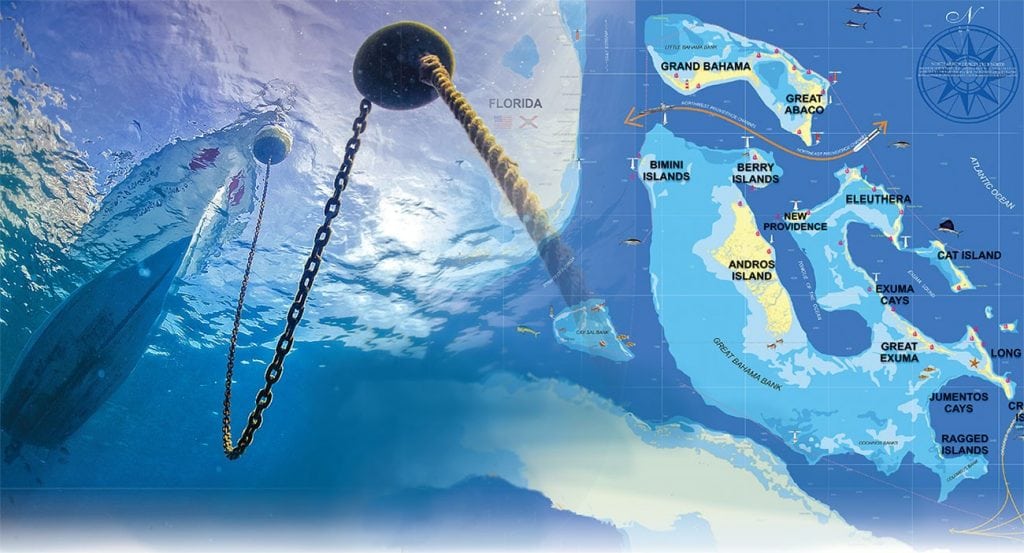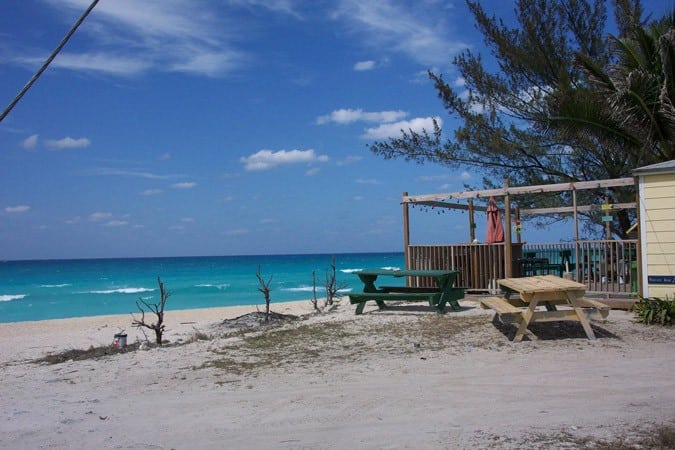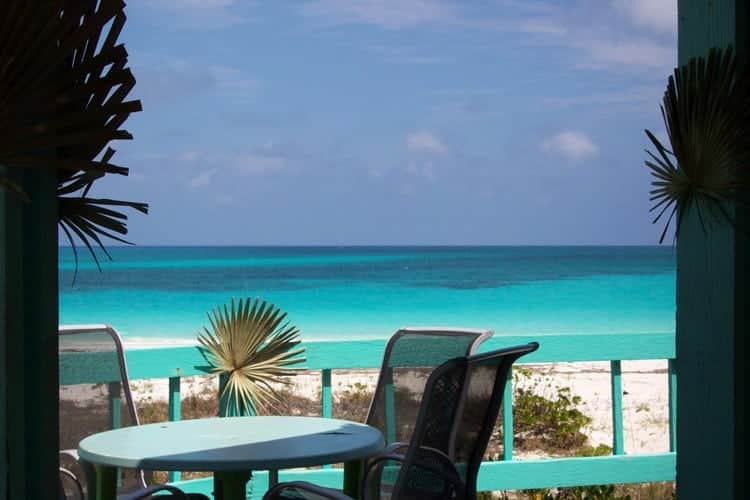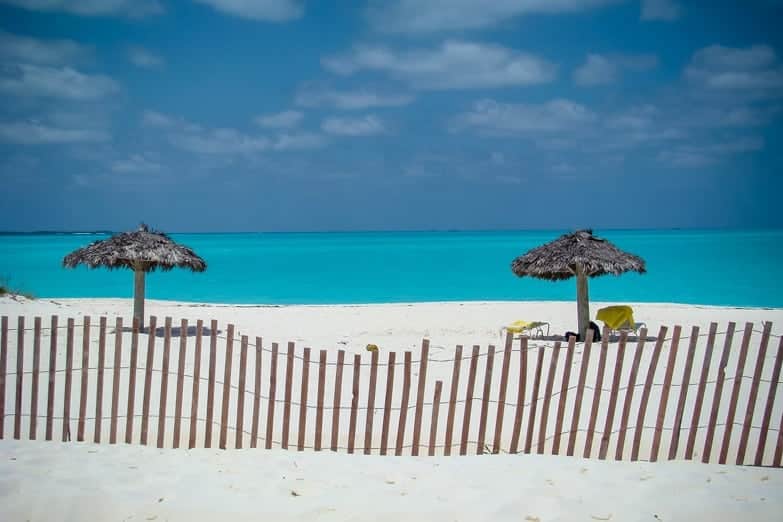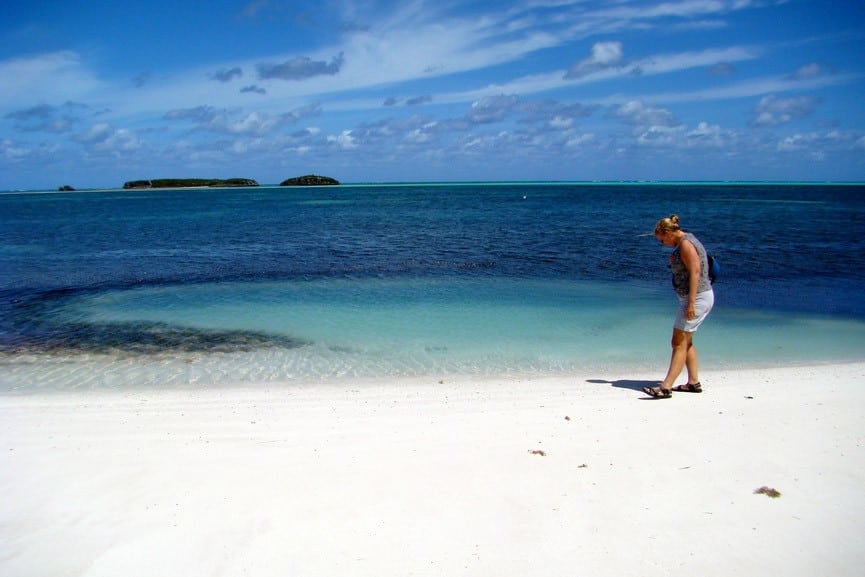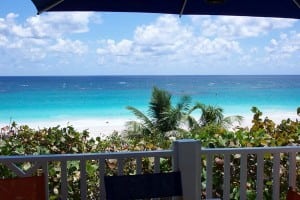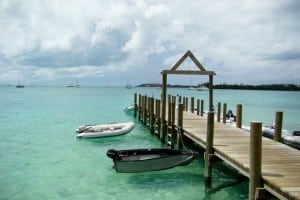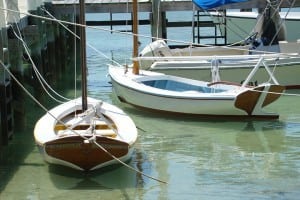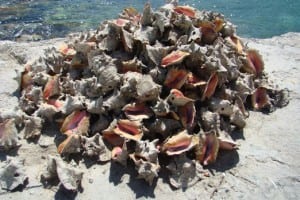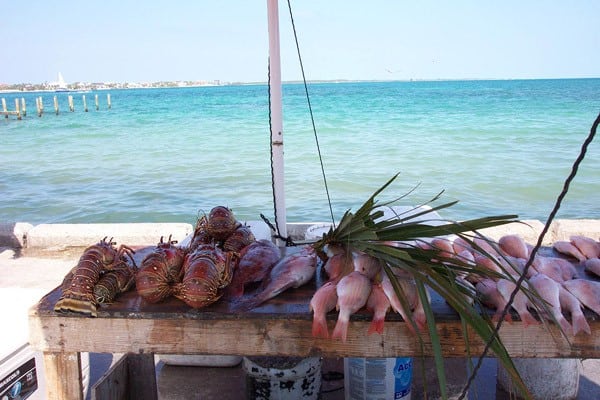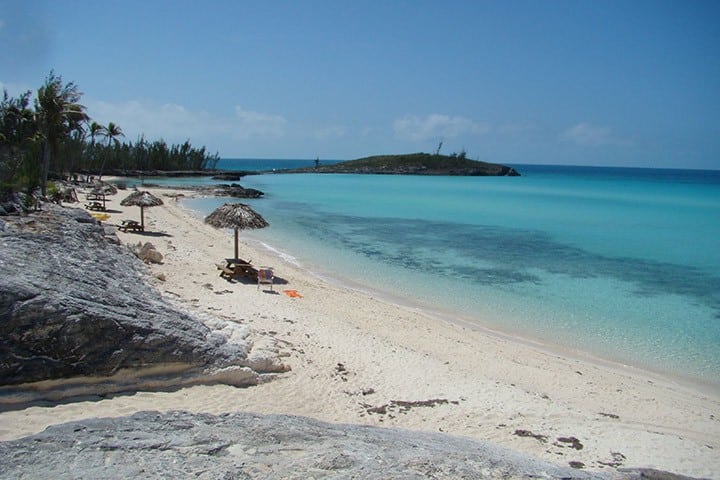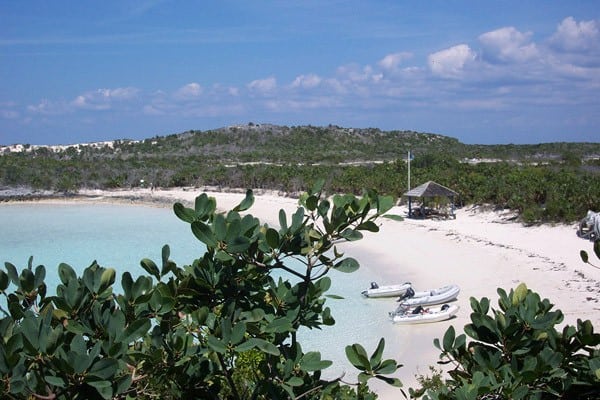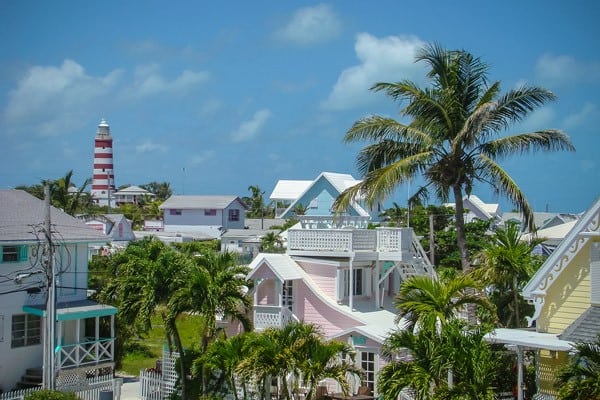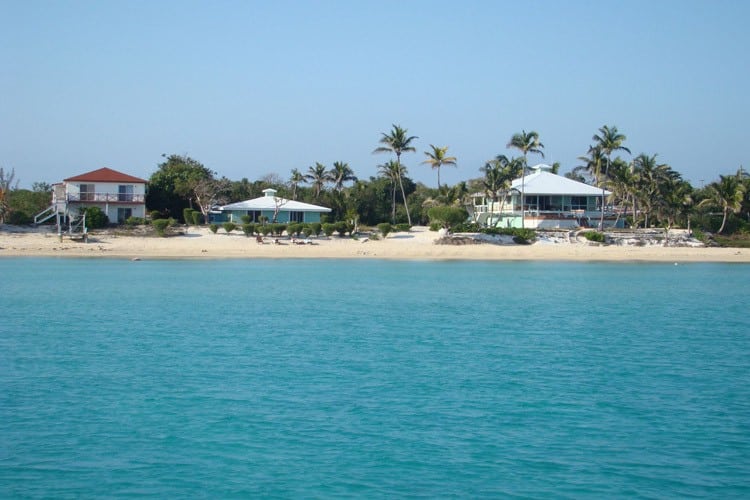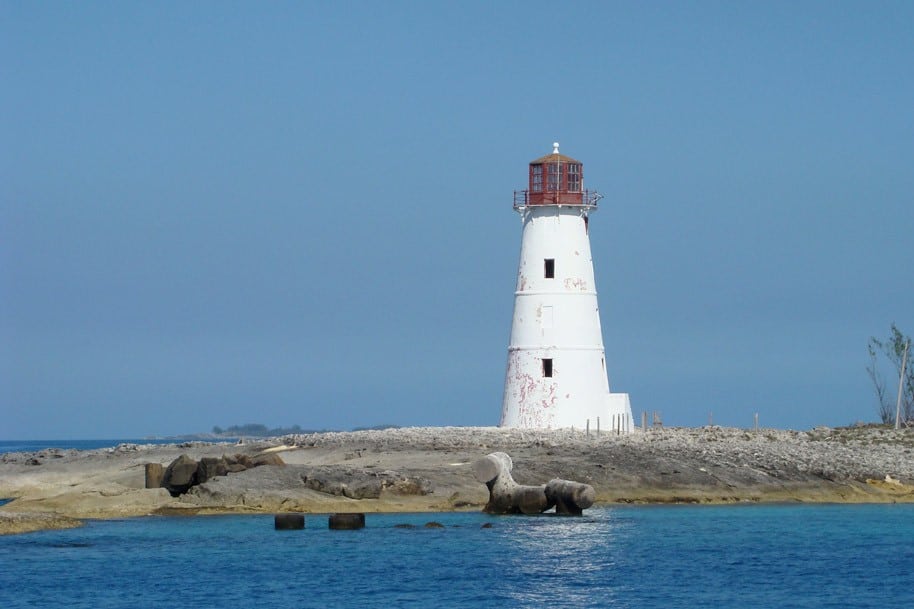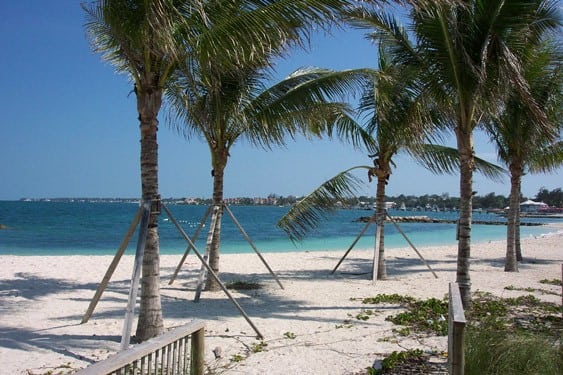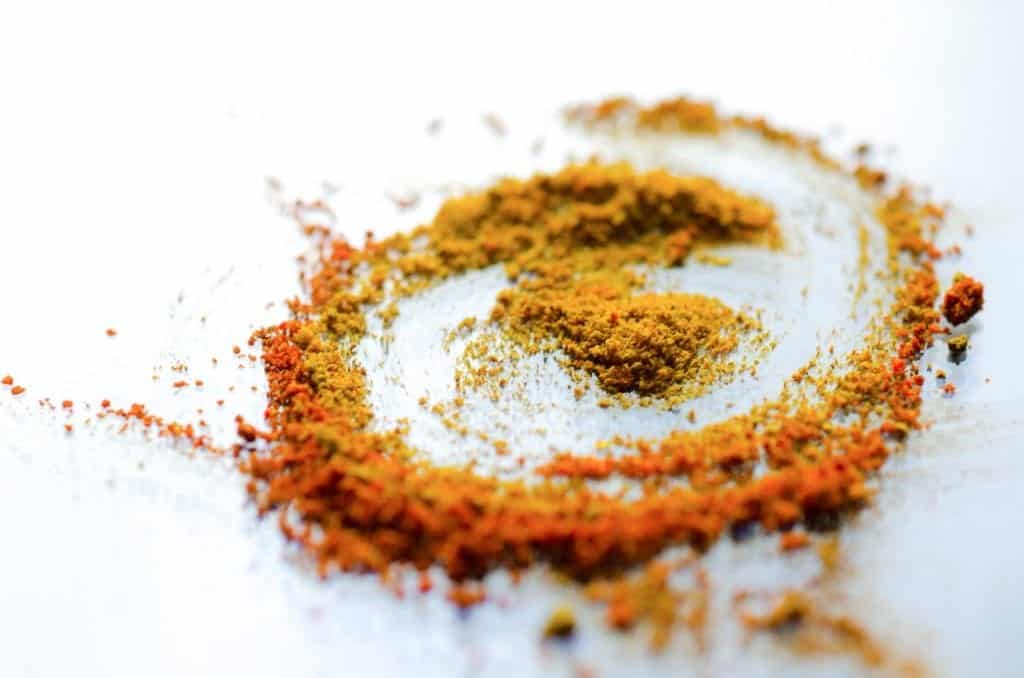An experienced couple shares their favored routes and their tips for anchoring in the Bahamas.
No matter how many times we cruise The Bahamas we cannot wait to return to its pristine beauty. Like many cruisers, we have our favorite routes and islands. Anchoring in the islands offers some unique challenges since bottom conditions vary widely—there is excellent sand but also scoured-out rocky channels, heavy grass, and thin sand over rock. Here our some of our best tips for anchoring in The Bahamas.
Heavy grass fouls the anchor, and thin sand over rock doesn’t give the anchor a chance to dig in, but we generally find good holding. Entering some anchorages requires complete vigilance and attention to depths, but the payoff is well worth the effort of time and attention. Here our some of our best tips for anchoring in The Bahamas.
1. Our preferred route from Florida to The Bahamas is via Bimini to clear Customs.
The most preferred spot to anchor is off the docks of the Big Game Club in Alice Town, where the marina offers dinghy access to town. The second is at the northern end of the harbor near the new resort and casino, Resorts World. As with any anchorage in The Bahamas, check to be sure the anchor is well set and be aware of strong currents in Bimini Harbor.
2. Upon departing the Bimini area, you’ll either head north to North Rock or south to North Cat Cay to cross onto the Great Bahama Bank.
Deeper-draft vessels will find better depths on the northerly route across. From Bimini, we head north to North Rock and then almost due east to Great Harbour on the northern end of the Berry Islands. Leaving at daybreak and heading across the banks puts you close enough to anchor and finish the trip the next morning (for slower vessels) or a long day to anchor at dusk for trawlers. The anchorage at Bullocks Harbor gives easy access to the settlement and the town dock for landing the dinghy. There is thick grass on the bottom, so look for a sandy patch to drop the anchor. Inside Hawksnest on the east side of Great Harbor Cay is a spectacular anchorage with miles of white sandy beaches. Soldier Cay, Hoffman’s Cay, White and Fowl Cay offer more solitude and exploration possibilities. Cruisers can easily spend a month or more just exploring the many anchorages throughout the Berry Islands.
3. Nassau on New Providence is the next port of call.
Anchoring in the harbor can be difficult since the current has scoured it clean, but there are a couple of sandy patches with fair holding just west of the bridge to Paradise Island or off the eastern channel near the Nassau Harbour Club. Be aware, however, that currents are strong and boat wakes are a problem. If you don’t need provisions or have already cleared in, we recommend anchoring at Rose Island located northeast of New Providence. It’s far away from everything but a good place to stage to head south into the Exumas.
4. Your next destination will be the Exumas.
Anchorages are plentiful and each should be considered based on the how much wind protection you need and from what direction. The trip from Nassau or Rose Island to Allen’s Cay is about 28nm and takes you across the “dreaded” Yellow Banks. The banks, however, are not as formidable as some would suggest. Ensure you have the sun high overhead and someone positioned on the bow, flybridge or the mast for a good view of your path ahead. The coral heads are easily negotiated.
5. As you travel south in the Exumas your daily runs will be short.
Don’t miss any of the wonderful anchorages in the 100 or so miles to George Town. Some of the highlights are Allen’s Cay with its greedy iguanas, Norman’s Cay with its cozy inner anchorages, Warderick Wells—possibly the most beautiful place on earth—, Staniel Cay with its Thunderball Grotto of James Bond fame, and the swimming pigs of Big Majors Cay. Farther to the south is the settlement of Black Point, another friendly outpost, and Farmer’s Cay with its yacht club festivities. Between there and George Town are any number of remote locales to drop the hook. Deep-draft boats will likely exit at Galliot Cut to make for George Town, while shoal-draft vessels can travel along the inside to Rat Cay, Square Rock or Glass Cay Cuts before heading out into Exuma Sound for George Town at Conch Cay.
Many boats just make for George Town and plant themselves there for the duration. Once you get there, it’s easy to see why. There are activities every day on the beaches on Stocking Island, places to provision ashore and new friends to make. Anchor off Stocking Island in the various locations—Church Bay, Volleyball or Sand Dollar Beaches—or just off the town in Kidd Cove for provisioning or laundry. Or, try Red Shanks behind Crab Cay on the south side of the harbor. Settling in Georgetown is one of our favorite tips for anchoring in the Bahamas
6. Departing George Town, head back north in the Exuma chain to Warderick Wells again as it deserves two stops.
From there exit Warderick Cut and make the run northeast to Powell Point on Eleuthera. Head around and into Rock Sound and anchor just off of the settlement.
7. From Rock Sound north there are any number of great anchorage stops.
This includes South Palmetto Point, Governors Harbour, Hatchet Bay, and Spanish Wells. None of the anchorages are very far apart making for easy trips. The area around Spanish Wells is deserving of at least a few days at exploration due to its interesting history. Take the ferry to Harbour Island to explore Dunmore Town.
8. From Spanish Wells make your way north to the Abacos.
The crossing to Little Harbor from either Spanish Wells or Egg Island ranges from 45 to 50nm. Enter through the reef between Little Harbour and Lynyard Cay; head north for the anchorage behind Lynyard or south to the wonderful Little Harbour. The harbor is for shoal-draft vessels only and will be your key to rich Abaco history and of the Johnston family who settled this area. Lynyard Cay is close enough to anchor and dinghy to Little Harbour, and provides good holding and protection from prevailing easterlies.
9. As you work your way north, on the north end of Elbow Cay is Hope Town, a must-see.
Anchor outside of the harbor and dinghy in—anchoring inside is now prohibited. The hub of the Abacos, Marsh Harbour, is only about 10nm to the west and Man O’ War is just to the north. These are all wonderful places where you could spend months.
10. Moving on to the Sea of Abaco, two of our favorites are Treasure Cay and Green Turtle Cay.
We also love the anchorage at Manjack Cay. Powell Cay is a short hop north of Manjack with Spanish Cay just beyond.
11. Once you reach Crab Cay head west toward Hawksbill Cay and Fox Town.
Your exit from The Bahamas will take you past Great Sale Cay. Anchor in the cove on the west side or on the east side for those occasional westerlies. Then, head beyond Mangrove Cay to anchor near West End.
12. Cross to Florida’s Lake Worth Inlet, a distance of about 56nm, or to St. Lucie Inlet, about 67nm.
Wherever your destination in The Bahamas might be this time around, there will always be more anchorages to explore on your next trip.
Helpful Tips for Anchoring in the Bahamas:
Anchors & Equipment
During our last journey through The Bahamas, the “next generation” anchor proved itself to be the best all-around anchor we’ve used—there are brands with very similar designs and characteristics that perform well. The prudent skipper will carry a second anchor for those severe weather conditions and the few times a second anchor is needed to deploy a Bahamian Moor.
The Bahamian Moor is two anchors set off the bow at a 180° angle from each other, used to keep the boat’s swinging circle limited to a small area. It’s good for strong reversing currents like those found in cuts, or where there is limited space. In many of our anchorages, good holding in deep sand is the norm. Even in a sandy bottom, small patches of rock and coral are often present.
You should also have a sufficient amount of the correct size chain as a primary part of the anchor rode. Most anchoring will be done in 10 feet or less, so a minimum of 100 feet is recommended, but the more, the better. Nylon anchor rode can and will chafe through very quickly when rubbing back and forth on a piece of rock or coral.
Finding the Right Spot
Anchoring in The Bahamas offers some unique challenges. Often heavy grass will blanket large sections of some of the better anchorages, which prevents the anchor from setting properly. Look for sandy patches seen as white patches within the grass. Pull forward to the edge of the sandy patch, drop the anchor and back down slowly until the anchor has set about in the center of the patch. Once the anchor rode is stretched out, back down slowly until you are comfortable the anchor has set. It’s a wise idea to snorkel over the anchor to be sure it is indeed set.
Beware of what might look like a sandy bottom but is actually a thin layer of sand over rock or coral. If the anchor appears to be set, it may only be in a narrow crevice and will release as soon as the boat shifts on the rode. Many times the anchor will simply skip across the bottom. In this situation, it’s often best to try and relocate to another spot.
Weather conditions and wind strength and direction will play a very important role in where to safely anchor. Make monitoring the weather and knowing what conditions to expect part of your regular anchoring routine.
By Chuck Baier, Southern Boating May 2015
About the Author: Chuck Baier and Susan Landry have cruised for almost 25 years, first on their Mariner 40 Ketch Sea Trek, and currently on their Marine Trader trawler Beach House. Chuck and Susan are owners of Beach House Publications, publishers of The Great Book Of Anchorages series of anchorage guides, which cover the Chesapeake Bay; Atlantic ICW from Hampton Roads/Norfolk to Key West and include the St. Johns River; The Bahamas-The Route Most Traveled; and the Gulf Coast from Cape Sable to Mobile, including the Okeechobee Waterway.
Additional tips for anchoring.


